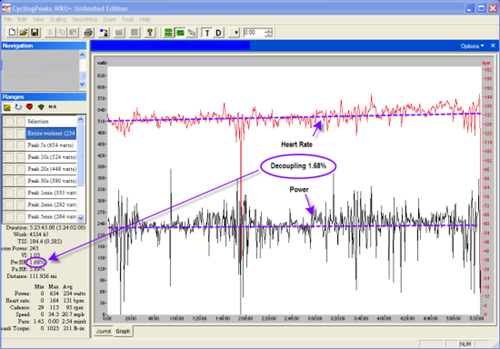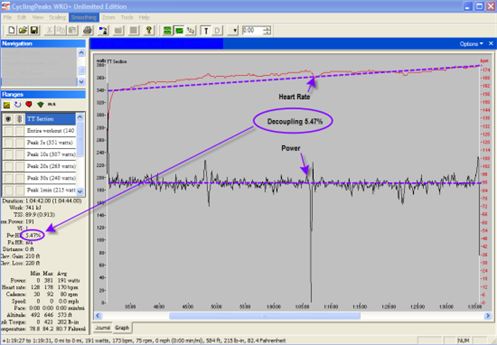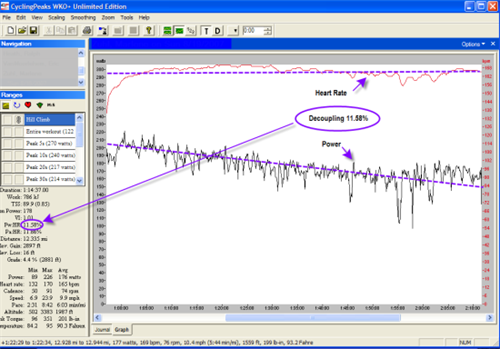An important lesson every competitive endurance athlete eventually learns is that the general preparation (“base”) period of the season is the most important time of the year. It’s then that the fundamental abilities of aerobic endurance, force and speed skill are developed. If these abilities are fully formed, then the more advanced, race-specific abilities of muscular endurance, anaerobic endurance, and power may be built on this solid foundation in the specific-preparation (“build”) period. Excellent general fitness created in the base period is necessary to produce high levels of sport-specific fitness for later in the season. Summer races are won with winter training.
The Importance of Aerobic Endurance
Of the basic abilities, the most critical for endurance athletes is aerobic endurance. Sports such as triathlon, road cycling, mountain biking, and distance running are first and foremost dependent on the aerobic system — composed primarily of the heart, lungs, blood, and the muscles’ aerobic enzymes.
The way to cause any physiological system to become more fit is to stress it regularly with an appropriate level of intensity for an appropriate duration until it has reached an optimal level of adaptation. Once this is accomplished, the system’s new level of function may be maintained for several weeks with stress at the same level of intensity and for a similar duration but with far less frequent training stress. Coaches and athletes once believed that long, slow distance (LSD) was the key to developing the aerobic system. But now, the trend is toward employing a moderate intensity at or slightly above one’s aerobic threshold coupled with an appropriate workout duration to produce optimal aerobic endurance. The trick is getting the intensity and the duration of such workouts right.
So how do you find the level of intensity that targets the aerobic threshold (AeT)? This is dependent on your sport. For cycling the AeT is generally to be found in the range of 55% to 75% of Functional Threshold Power (cFTP). Experienced, serious riders typically reap a greater reward by working in the upper half of this power zone when doing AeT training with a power meter. A runner will generally use pace or speed to do AeT workouts at 75% to 85% of their Functional Threshold Pace (rFTP). And just as with cycling, the serious and experienced runner with do AeT workouts in the upper half of this zone-80% to 85% of rFTP.
But how do you know if your aerobic endurance is progressing? And how do you know when you’ve done enough such training to reach an optimal AeT fitness level? The answer to both of these questions may be found by comparing power or speed with heart rate. When training at the AeT intensities described above, you may expect to see heart rates approximately in Zone 2 according to the heart rate zones as described in my Training Bible books.
What is Decoupling in Training?
While there is little on this in the scientific literature, the limited research available appears to indicate that when aerobic endurance improves, there is reduced heart rate drift relative to constant outputs (power and speed). And, of course, the reverse of this is that when the heart rate is held steady during extensive endurance training, the output may be expected to drift downward. This parallel relationship between input (heart rate) and output (power or speed) is referred to as “coupling.” When they are no longer parallel in a workout, as one variable remains steady while the other drifts, the relationship is said to have “decoupled.” Excessive decoupling would indicate a lack of aerobic endurance fitness.

How to Test Decoupling
The AeT portion of the workout is split into halves. For each half, the normalized power (cycling) or speed (running) is divided by the average heart rate to establish two ratios. The ratios are then compared by subtracting the first-half ratio from the second-half ratio and dividing the remainder by the first-half ratio. This produces a power-to-heart rate-ratio percentage of change from the first half to the second half of the aerobic threshold ride. That percentage of change is your rate of decoupling. The following is an example of how the power-to-heart rate ratio percentage of change is calculated. The same method is used for running by substituting speed for power unless running power data, with properly set thresholds, is available in the workout file.
- Determine the power-heart rate ratio for the first half of the ride: Power average = 180 watts, Heart rate average = 135 bpm. First half power-heart rate ratio = 1.33 (180 / 135)
- Determine the power-heart rate ratio for the second half of the ride: Power average = 178 watts, Heart rate average = 139 bpm. Second half power-heart rate ratio = 1.28 (178 / 139)
- First-half ratio minus second-half ratio = 0.05 (1.33 – 1.28)
- Remainder divided by the first half ratio = 0.038 (0.05 / 1.33)
The decoupling rate is 3.8%.
I have found that aerobically fit endurance athletes experience a decoupling rate of less than 5%. The accompanying figures illustrate different rates of decoupling from less than 2% to more than 11%. As decoupling increases, it becomes obvious simply by observing the separation in the charts without even knowing the calculations.



So one of our goals when working on AeT is to keep decoupling to a minimum-less than 5%. When decoupling happens during an AeT workout is just as important as how much decoupling occurs. In other words, it’s possible for coupling to occur for the early portion of an AeT workout, followed by an excessive decoupling in the latter portion. That may be acceptable when training for short-course races. Athletes who race in relatively short endurance events such as bicycle criteriums lasting less than an hour, sprint- and Olympic-distance triathlons, and 5k and 10k running races don’t need as much aerobic endurance as longer-course athletes. So how long are the AeT workouts with the decoupling rate staying below 5%? It increases as the race duration increases.
In TrainingPeaks, decoupling is found using the Pw:Hr And Pa:HR tools when analyzing a workout file.
Aerobic Decoupling is a great tool to determine if aerobic endurance for a given duration and a given output is strong enough to remain aerobic for a single workout. Keep in mind, values for efforts under 20 minutes in duration require more refinement when measuring decoupling.
WKO+ software can help you determine your degree of aerobic endurance conditioning by displaying and measuring your level of decoupling. Once you achieve an excellent level of aerobic fitness, the heart rate and power or speed graphs on WKO+ will be parallel or nearly so.
Decoupling In Cycling
How long should optimal decoupling last relative to your race duration? There is no research to back this up, but based on experience, for cycling, I use two to four hours of steady AeT exercise as the common range. For running, it is one to two hours. The longer the event, the longer the coupling necessary for success. If your cycling-related race duration typically falls into the two- to four-hour range, simply train for that duration at AeT. For example, if you do the bike portion of a half-iron-distance triathlon or bike road race with a typical time of around 2.5 hours, then do 2.5-hour AeT bike workouts (not including warm-up and cool down). Should your race times be less than two hours (criterium bike racing and sprint- or Olympic-distance triathlon bike portions), then your AeT bike workout is two hours. If your event takes longer than four hours (Ironman-distance bike and long road races), your AeT bike workout will be four hours in duration.
Decoupling in Running
For running, use the same procedure as above, only with a one- to two-hour AeT workout range. If your race lasts between one and two hours, do AeT workouts as long as the expected race duration. If your race will take fewer than 60 minutes, then one-hour AeT workouts are employed. For races lasting longer than two hours, run two-hour AeT workouts.
AeT workouts of the appropriate duration are done once or twice weekly per sport in the Base period. Start with a shorter duration based on your fitness level, and over the course of a few weeks, gradually lengthen the AeT portion to the goal duration. When heart rate and pace or speed are coupled (less than 5% decoupling) for the goal duration, then aerobic endurance fitness is considered to be optimal, and you are ready to move on to the next stage of training — the build period.
How to Do an Aerobic Threshold Coupling Workout
Note that there are two ways to do an aerobic threshold coupling workout. You can ride or run while keeping your heart rate steady to see what happens to power or speed. Or you can maintain a steady power or speed and see what your heart rate does. In the Base period, it’s generally better to maintain a steady heart rate, while for the Build period, when you are maintaining AeT fitness, keep power or speed steady.
Besides low aerobic endurance, decoupling may also occur due to a failure to take in fluids at a rate that prevents excessive dehydration during a workout. Also associated with decoupling is environmental heat stress, which can cause the heart rate to rise or power/speed to fall. One would expect the rate of decoupling to decrease as heat adaptation takes place, but I know of no research on this matter. However, I have seen it happen with athletes I coach who live in hot places such as Phoenix, Ariz. Decoupling may also be expected to increase if you go to a high altitude location such as Boulder, Colo. And just as with heat, expect your decoupling rate to improve as you adapt to the higher altitude.
References
Boudet, G. et al. (2004, December). Heart rate-running speed relationships during exhaustive bouts in the laboratory. Retrieved from https://pubmed.ncbi.nlm.nih.gov/15630146/
Lajoie, C. et al. (2000, August). Physiological responses to cycling for 60 minutes at maximal lactate steady state. Retrieved from https://pubmed.ncbi.nlm.nih.gov/10953063/
Mounier, R. et al. (2003, October). Effect of hypervolemia on heart rate during 4 days of prolonged exercises. Retrieved from https://pubmed.ncbi.nlm.nih.gov/12968211/
Vautier, J.F. et al. (1994, January). Prediction of exhaustion time from heart rate drift. Retrieved from https://pubmed.ncbi.nlm.nih.gov/7516735/
Wingo, J.E. et al. (2005, February). Cardiovascular drift is related to reduced maximal oxygen uptake during heat stress. Retrieved from https://pubmed.ncbi.nlm.nih.gov/15692320/
Wingo, J.E. & Cureton, K.J. (2006, July 29). Body cooling attenuates the decrease in maximal oxygen uptake associated with cardiovascular drift during heat stress. Retrieved from https://pubmed.ncbi.nlm.nih.gov/16896737/
Wingo, J.E. & Cureton, K.J. (2006, July). Maximal oxygen uptake after attenuation of cardiovascular drift during heat stress. Retrieved from https://pubmed.ncbi.nlm.nih.gov/16856352/








